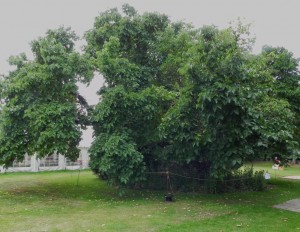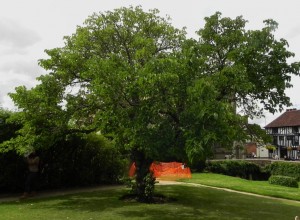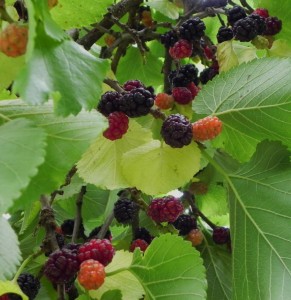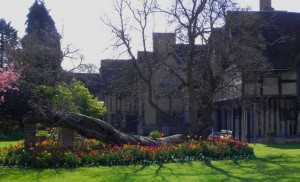Last Sunday, 4 August 2013, one of Stratford’s mulberry trees split in two. There are many ancient mulberries in the town, principally in the Shakespeare Birthplace Trust’s gardens, and they’re mostly propped up by metal or brick supports, making them look much older than they are: according to the Royal Horticultural Society “The mulberry tree has a spreading habit and becomes crooked and gnarled with time”.
All the more unfortunate that the tree that broke is not one of the older trees, but was planted in 1969 in New Place Garden to mark the 200th anniversary of the Garrick Jubilee, the first organised celebration of Shakespeare, usually seen as the beginning of the tourist industry in the town. It was planted by Dame Peggy Ashcroft, and has additional significance because she also chose to have her ashes scattered beneath this tree after her death.
Several other mulberries are to be seen in the same garden, principally that which, by tradition, is a scion or cutting from the one which Shakespeare himself planted in this garden. It’s certainly a venerable and massive tree, still bearing fruit. So well-known had the original tree become in the 1750s that the then resident of New Place, the Rev Francis Gastrell, grew tired of the constant requests to see it and chopped it down. Local entrepreneur Thomas Sharpe spotted the opportunity and purchased the wood from which he made many objects, the most important being the carved casket which was presented to David Garrick containing the freedom of the town. So many smaller souvenirs were also made that their authenticity was placed in doubt and Sharpe ended up having to swear that items were the real thing. Gastrell, falling into a dispute over local taxes, in 1759 demolished the house itself and left the town forever.
Another of the mulberries in New Place Garden was the source of controversy when in 2012 the SBT applied for permission to cut it down. This had been planted in 1946 to replace an earlier tree on the same spot, and unfortunately stands just where archaeologists thought it would be worth investigating as part of the Dig for Shakespeare excavations of the site. Permission was not granted: perhaps Stratford District Council’s Planning Department were concerned about the potential headlines if another of Shakespeare’s mulberry trees was allowed to be given the chop.
The story that the tree felled by the Rev Francis Gastrell had been planted by Shakespeare is quite likely to be true. In the early years of James 1’s reign, around 1609, landowners were instructed to plant mulberry trees in the hope of promoting a native silk industry, and this was just the time when Shakespeare was spending more time in his large house, New Place. But the mulberry trees which were imported and sold were the wrong sort, black mulberries rather than the white variety which have delicate leaves the silkworms feed on. Black mulberries have delicious, very juicy fruit, which can be eaten straight off the tree and also make excellent pies and preserves, but are less favoured by silkworms. The fruit is held underneath the leaves and when ripe turns black and drops off the tree, staining anything it touches. Shakespeare knew how tricky the berries were to pick. In Coriolanus the hero is encouraged to stand with his head held low:
Now humble as the ripest mulberry
That will not hold the handling.
The royal connection with the mulberry tree is still celebrated: the National Collection of Mulberries is planted in the grounds of Buckingham Palace, and there’s much information on the history of the tree in the UK on this website
In A Midsummer Night’s Dream, Shakespeare stages the classical story of Pyramus and Thisbe. The lovers are to meet at Ninus’ Tomb, beneath a mulberry tree. When Pyramus arrives to find only Thisbe’s bloodstained scarf, he stabs himself, his blood staining the white mulberries dark red. Ever afterwards the mulberry has dark red juice. Shakespeare doesn’t include the detail of the mulberry tree directly, but he does refer to it:
This grisly beast, which Lion hight by name,
The trusty Thisby, coming first by night,
Did scare away, or rather did affright;
And, as she fled, her mantle she did fall,
Which Lion vile with bloody mouth did stain.
Anon comes Pyramus, sweet youth and tall,
And finds his trusty Thisby’s mantle slain:
Whereat, with blade, with bloody blameful blade,
He bravely broach’d is boiling bloody breast;
And Thisby, tarrying in mulberry shade,
His dagger drew, and died.
What’s happened to Peggy Ashcroft’s tree may be regrettable, but it is only to be expected. The RHS explains. ” As trees mature, mulberries have a tendency to lean or suffer from split limbs. To avoid splits or having to make large pruning cuts, prop low-lying branches before their weight causes them to break”. It’s not all bad news though: these trees have real presence, as with the one at Hall’s Croft which appears to be growing horizontally among a bed of flowers. Once it’s supported this one too will begin to assume the character that these lovely trees acquire with age.






